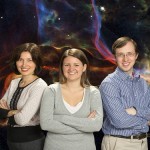
Right on the solstice, a ‘great conjunction’ of Jupiter and Saturn will occur when the two planets converge shortly after sunset Australia time tonight, Monday 21 December. They will appear almost as one object, being at one point only a fraction of a degree apart.
A conjunction of Jupiter and Saturn occurs around once every 20 years, but this is the closest they have been together since 1623, says Associate Professor David Coward from the University of Western Australia’s School of Physics, Mathematics and Computing.
“Although the event is not scientifically important, the spectacle will offer viewers a real treat to admire the beauty of this rare alignment,” he says.
How to see the conjunction
“Look west toward the ocean a few hours after sunset and bring your binoculars, camera or a small telescope,” says UWA scientist Dr Bruce Gendre, from the Centre of Excellence for Gravitational Wave Discovery (OzGrav-UWA). For those in WA he recommends Perth’s beaches as offering uninterrupted views of the western sky.
“You should see Jupiter with its four largest moons in a row in addition to Saturn. You will see a bright spot slightly elongated and it will appear as one the first stars of the night.”
Hopefully, of course, the view won’t be obscured by cloud cover.
Look out for wise men
It is just possible that a similar conjunction back in 7BC was responsible for a bright ‘star’ in the the sky which may have sparked the biblical legend of a star marking the birth of Jesus — if this story has any basis at all in historical fact.The shining star that heralded the birth of Jesus is mentioned only in the Gospel of Matthew, and the text is not very scientifically informative, making it difficult to identify the star as a celestial event. The uncertainty of an accurate date for the birth of Jesus further complicates an identification.
That hasn’t stopped scientists offering a wealth of explanations over the years for what led the three wise men to Bethlehem: suggestions have included a comet, a nova, a supernova, the planet of Venus,
a powerful shooting star, and a constellation of bright planets combining to emit bright light.
According to modern astronomers, the last of these is the most likely explanation. Particularly notable in this regard is the triple conjunction that occurred between Jupiter and Saturn in 7 BC. Three times within seven months the two planets passed closely by each other, an event which happens only once every 900 years. The two bright planets merging in the sky might well have made such an impression that the light could have been considered a sign from God.
The timing of the celestial events is consistent with historical estimates of the year in which Jesus was born, placing this between 4 BC and 8 BC.
Another candidate for the bright star above Bethlehem is the conjunction between Jupiter and Venus in June of the year 2 BC. Observed from Earth, the two bright planets would have merged.

End of an era
Astrologists are apparently pontificating that this conjunction of Jupiter and Saturn will mark the end of a two-hundred-year era and will be associated with significant social change.
But we think the physical event is quite exciting enough without allocating it any unlikely supernatural effect.
And if you miss it, mark your diary for 31 October 2040, or better still for 15 March 2080, when the next extra-close encounter between the two planets will take place.






